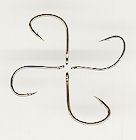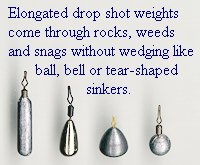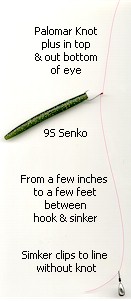Become a Dropshot Hotshot
Need
a New Year's Resolution? Make a vow to master the dropshot in
2002.
On deep lakes that are clear to slightly stained, you'll want
to use the drop shot rig. It is not hard to master with the
proper equipment and a few days practice on a deep body of water
near you in 2002!
Rod, Reel, Line
Most drop shot hot shots use spinning gear. Spinning can be
better than baitcasting for drop shot due to reasons such as:
- The way light line spills easily off an open bail spinning
reel as the drop shot weight plummets toward bottom.
- The ability to crook your right index finger in constant
contact with the line to feel what the heck's going on down
there.
- Plus, as you hold a spinning rod your arm angle is better to
load up the tip for a sweep set of the hook.
During the last two years of researching my own and other drop
shot anglers' gear, I've tested a dozen different spinning rods,
several reels and assorted varieties of lines to drop shot. The
best drop shot rig by far I've tried was a $400 reel on a $400
rod with special spinning fluorocarbon line - all sold only in
Japan.
Here in the USA, I currently use the following combination,
which weighs in the $250 price range:
- Rod: Many rod vendors are introducing or re-marketing
rods as drop shot rods, so 2002 should see a constant
introduction or re-introduction of rods for dropshotting. Gary
Yamamoto has just introduced his new dropshot rods as of writing
this, and they are an instant winner on my boat. Another rod I've
enjoyed for dropshot fishing are the Quarrow
ML3 IM7 Model OTS704F 7'0" Medium Power / Fast Taper.
- Reel: Shimano Stradic 2000FG
The reel has a good drag, which is a requirement of drop shot
angling.
- Line: Maxima Ultragreen 6 lb. test
Something about 6 lb. Ultragreen makes it fine for drop shot
line. In addition, the sport's best dropshotter, Aaron Martens
has been reported to prefer 6lb. P-Line
CXX-XTRA STRONG moss green in most situations.
Price was not a factor in my quest for good drop shot gear. I
tried more and less expensive rods, reels and lines before
"evolving" into a working comfort level with the above
combo.
I'm still searching, and if or when I find anything better,
I'll let you know about it. Until then, I feel you can use the
above examples as a guide to what's good drop shot gear.
Hook
 As far as the size of a hook,
there is no consistency in the industry across manufacturers or
models. For example, a #4 GYCB Split Shot hook is bigger than a
#2 Owner Mosquito which is comparable size to a #1 Gamakatsu
Split Shot/Drop Shot model. As far as the size of a hook,
there is no consistency in the industry across manufacturers or
models. For example, a #4 GYCB Split Shot hook is bigger than a
#2 Owner Mosquito which is comparable size to a #1 Gamakatsu
Split Shot/Drop Shot model.
Those are the three models and sizes I use most often, which
are all short straight shank hooks. I will routinely ratchet down
one hook size to use a diminutive bait like a 92T Tiny Ika or
ratchet up one size to wacky rig a fat-bodied bait like a small
Senko.
Most of the time, I nose hook baits. I nose hook only two ribs
back as I do not like to have the nose of the bait stick out so
much that it gets in the way of the hook point. This is important
since the way to hook a drop shot fish is to literally pull the
bait out of its mouth until the point barely catches behind the
shut upper lip. If the nose of the plastic sticks out too far, it
serves as a bumper to push the hook away from penetrating the
lip. So make sure the hook point is free and clear of plastic
that could clog it.
Hooking drop shot bass is begun with gentle rod pressure after
detecting a bite or a bass down below on the line. Use gentle
reeling and rod pressure as if to pull the bait and hook slowly
out of its mouth. This will only make the bass more determined to
clamp down and hold onto its prize. The hook will slip until it
catches like a splinter that barely sticks behind the upper lip.
Then the upper 25% of the rod tip will continue to bend and load
under pressure as you reel in slack moderately slowly. All this
takes a few seconds. The fish should often start to swim away
(hopefully not at you) which serves to set the hook beyond the
barb as you sweep the rod back in a confident controlled manner
while you reel down until full pressure of the fish's weight is
on the line.
Think of the hook set as a two step process. Actually, three
steps as follows:
- First come the "preliminaries." When you detect a
bite or a bass on the line below, you must first wait until you
sense the bass has the bait and hook in its mouth. Sometimes this
happens instantly, and some days it seems to take a long while.
Fortunately, most bass will act the same way on any given day. So
if you figure one out, you can apply the same successful chess
move to others.
- Second, we've already described above how to pull the line,
reel slowly and load the rod tip until the hook point pricks
behind the lip. The upper 25% of the rod tip should bend over and
load.
- Once the tip is loaded down, sweep the rod up as you reel to
sink the hook home. In this way, visualize that the hook is being
driven by the spot on the rod that's 25% down from the tip where
the backbone begins. The hook is not driven home in a jerk like
you would set the hook with a jig or Texas rig for instance.
If you do it right, you should be hooking most every bass in
the upper lip (or the corner of the mouth some days). You are
doing something not quite right if you hook them too deeply or on
the other hand, if you miss them.
Certain days, deep water drop shot bass will streak straight
to the top upon being hooked, shake their heads and throw the
hook if you let them. If one bass acts this way, expect others to
also act that way the same day. They usually all behave in
concert, and that's an important concept. I don't know why they
all act the same way on the same day, nor do I truly care except
in order to analyze how the behavior shown by a few bass can help
me predict how best to hook and land the majority of bass that
will bite, fight and behave in the same way for that day.
Drop Shot Knot
Okay, you'll need to use your imagination here, plus have an
illustration handy of a standard Palomar Knot:
- Thread the single line through the hook eye one way
- Double the line back forming a short loop, and thread two
feet of tag line back through the hook eye the other way
- Using the shorter loop end, tie the loop in an overhand knot
above the hook
- Pass the hook through the tip of the loop and slowly draw
tight
- Insert the two foot tag end down through the "top"
of the hook eye so the hook point faces up
Tag End of Line
You can leave as little as a few inches to a foot, but I like
to leave a generous two feet of tag line below the hook (above
the sinker). Importantly, two feet of tag line gives you more
"weightless free fall" for your bait at that precious
moment after the fast-falling sinker thuds down and stops when it
hits lake bottom. As it hits bottom, there's suddenly not a
sinker pulling the bait down quickly, and two feet of tag line
gives the bait a longer moment of weightless free fall. It also
gives the bait a longer leash to move up and down unweighted on a
slack line as you work the drop shot rig to attract bass.
Keep in mind, although the baited hook is tied two feet up the
line above the sinker, it is far less than two feet above the
lake bottom. This is due to line angle caused by distance cast,
boat movement, and line drag which bellies line out under water.
Nevertheless, two feet of tag line keeps the open hook from
snagging as often on an obstructed bottom full of rocks or weeds,
plus it keeps the bait flying higher like a flag above rocky or
weedy bottom.
So, those are three reasons why I like a longer tag line:
- to increase length/distance of weightless free fall,
- to keep the open hook higher above snags, and
- to keep the bait visible above obstructions.
Sinker
 A drop shot sinker has a
line-gripping swivel on top. The swivel grips the line tightly,
and it attaches in an instant. There is no need to tie a knot to
the sinker or swivel. The thin, elongated sinker (leftmost in
photo) is a Bass Pro Shops XPS Finesse Drop Weight in 1/4
oz. This one weight covers a lot of water. I have caught bass
from 1 to 90 feet deep on this one size of sinker. Plus, it slips
through rocks, brush and weeds better than other shapes. A drop shot sinker has a
line-gripping swivel on top. The swivel grips the line tightly,
and it attaches in an instant. There is no need to tie a knot to
the sinker or swivel. The thin, elongated sinker (leftmost in
photo) is a Bass Pro Shops XPS Finesse Drop Weight in 1/4
oz. This one weight covers a lot of water. I have caught bass
from 1 to 90 feet deep on this one size of sinker. Plus, it slips
through rocks, brush and weeds better than other shapes.
If targeting bass in water less than 20 feet deep, 3/16 oz.
may be better. In water deeper than 30 feet, 3/8 or 1/2 oz. may
be better.
A drop shot sinker is constantly in touch with bottom. It
clicks against hard stuff and the sinker stirs up soft sediment
(just like a Carolina rig sinker). Before you leave the dock, rig
up your rod and jiggle the sinker up and down on a rock on dry
land. You'll hear all the tap-tap-tapping which serves to attract
bass under water when you jiggle the tip.
A lot has been written about how to jiggle a drop shot bait
without moving the sinker. In actuality, it is pretty hard not to
move the sinker, but that's not bad! The sinker rolls and drags a
ruckus down there. It serves to attract bass.
Bait
Drop shot baits are basically straight without a lot of
appendages or twisty tails. Popular examples include Roboworm straight tail worms and Body Shad,
Magic Worms straight tail worms, Kamakazee and SnakeBite hand pours are a few examples. The
following section describes Gary Yamamoto Custom Baits.
 92T Tiny Ika: Think of the
92T as a bottom-dwelling bug larvae, a bitty crawdad, a tiny fish
of any species. This bait is non-descript, meaning it looks like
nothing exactly yet everything in general. That's a good
attribute for any lure to have! It's made of a hard plastic to
help it resist tearing off when nose-hooked with a light wire
hook. 92T Tiny Ika: Think of the
92T as a bottom-dwelling bug larvae, a bitty crawdad, a tiny fish
of any species. This bait is non-descript, meaning it looks like
nothing exactly yet everything in general. That's a good
attribute for any lure to have! It's made of a hard plastic to
help it resist tearing off when nose-hooked with a light wire
hook.
9B, 9C, 9J and 9S Senko: Nose-hook these small Senkos
or wacky rig them exactly in the middle. When wacky-rigged,
there's a lot of stubby plastic to get the hook point past. So I
generally ratchet up one hook size larger than nose-hooking the
same bait. The wacky rig acts just like a parachute that causes
the drop shot Senko to descend horizontally and much more slowly
than a nose-hooked bait (nose-hooked baits spiral tightly on the
fall). The wacky-rigged small Senkos should surely be tried when
fish suspend along sheer walls - or any sort of vertical
presentation that falls past fish holding above bottom. On the
way down, the wacky drop shot Senko will wriggle both tips
uncontrollably. I often like to downsize my trusty 1/4 oz sinker
to a lighter 1/8 oz that makes the wacky parachute fall
agonizingly slow. When a bass bites you on the way down, your
line will just stop falling and go slack. Set the hook using the
three steps in the section above.
 Series 7 Cut Tail Worm:
I've saved the best for last. The Cut Tail is the GYCB bait I
drop shot the most. I usually nose-hook it with the cut tail
pointing down, which causes the tail to quiver and shudder during
the brief moment of "weightless free fall" when there
is slack in the line. This only happens when the sinker is not
moving and therefore the sinker's not towing the Cut Tail around
by its nose. Just lower the rod tip to let some slack in the line
and it will happen. Keep your right index finger on the line
above the spinning reel. When you lift the rod tip again, your
finger's feeling for a bass that took the bait as it fell freely
on the slack line or rested motionless on bottom. Series 7 Cut Tail Worm:
I've saved the best for last. The Cut Tail is the GYCB bait I
drop shot the most. I usually nose-hook it with the cut tail
pointing down, which causes the tail to quiver and shudder during
the brief moment of "weightless free fall" when there
is slack in the line. This only happens when the sinker is not
moving and therefore the sinker's not towing the Cut Tail around
by its nose. Just lower the rod tip to let some slack in the line
and it will happen. Keep your right index finger on the line
above the spinning reel. When you lift the rod tip again, your
finger's feeling for a bass that took the bait as it fell freely
on the slack line or rested motionless on bottom.
Most of the time, the line is not totally slack. Most of the
time, even with the slightest line tension or line pressure, the
sinker is being dragged or bounced around the bottom, which gives
the Cut Tail a minnow-like darting action with a squiggly,
squirming tail movement as it's pulled around by the sinker, by
line tension and even the shortest rod tip movement will drag the
sinker, which pulls the bait around by its nose.
Well now! I don't know what else to tell you about the drop
shot, hot shot. It's really not hard to master if you follow the
suggested guidelines above.
| 